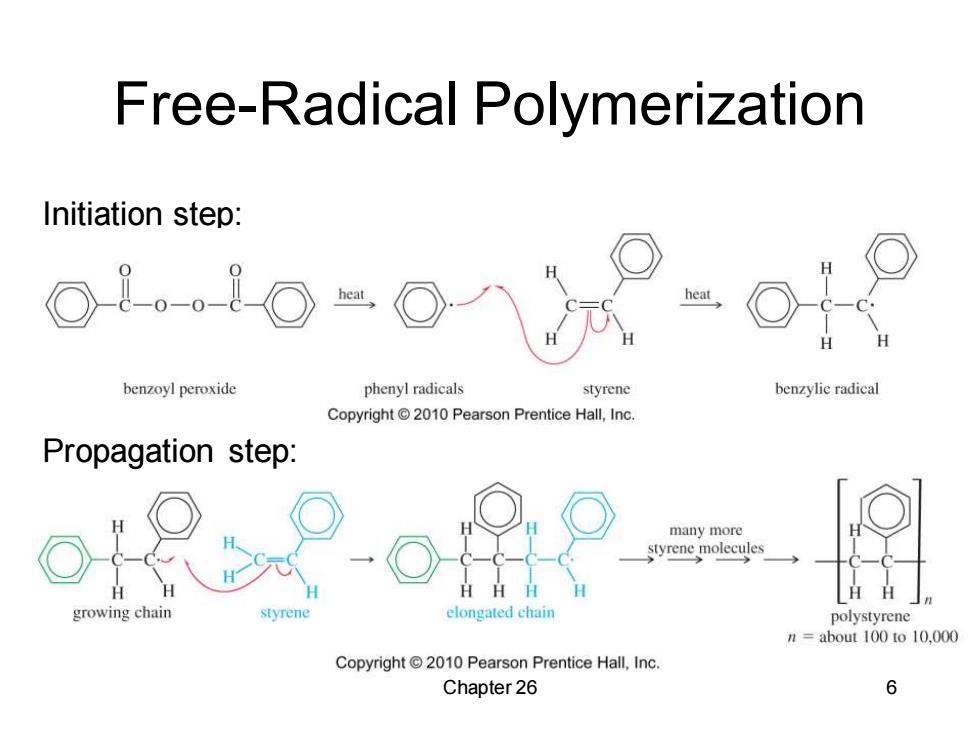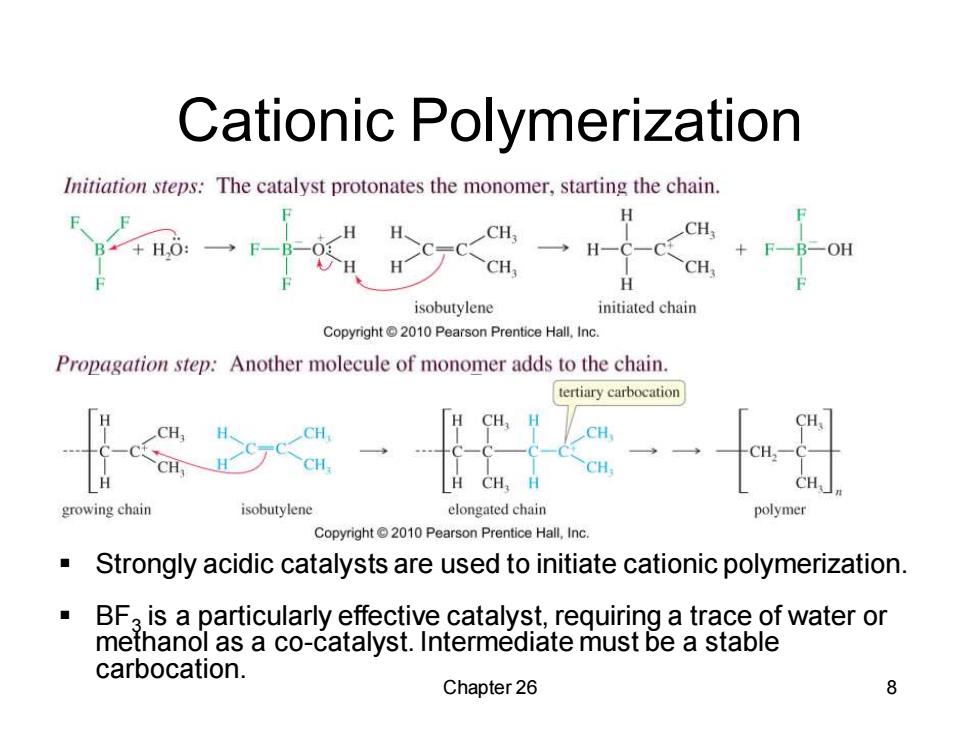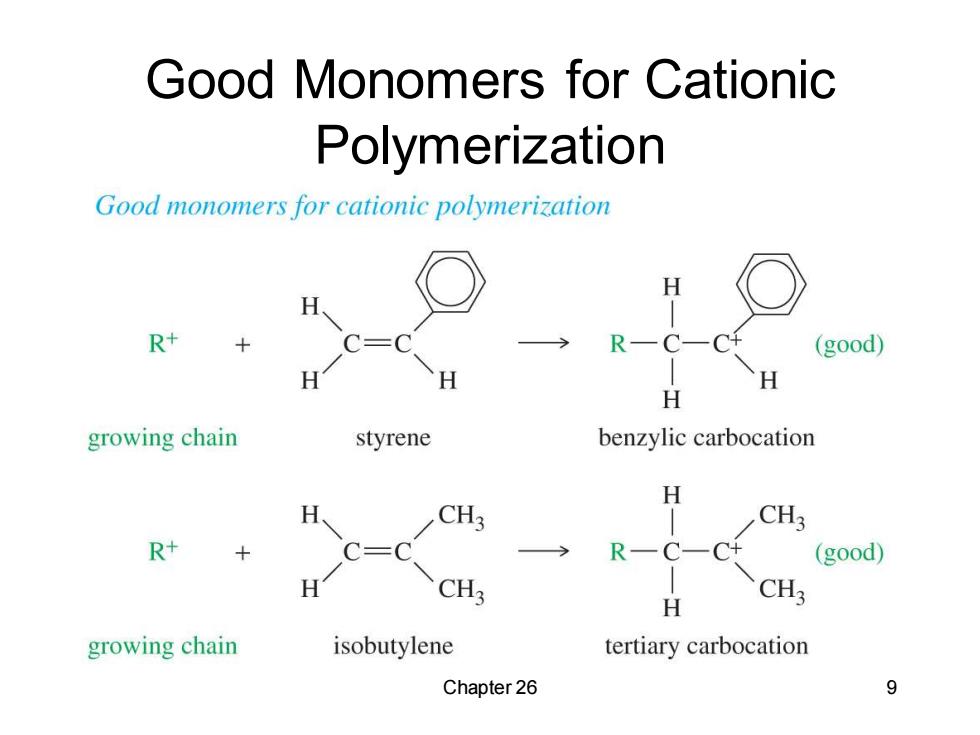
Free-Radical Polymerization Initiation step: O---O兰O benzoyl peroxide phenyl radicals styrene benzylie radical Copyright2010 Pearson Prentice Hall,Inc. Propagation step: many more styrene molecules H HH growing chain styrene elongated chain polystyrene n=about 100 to 10,000 Copyright 2010 Pearson Prentice Hall,Inc. Chapter 26 6
Chapter 26 6 Free-Radical Polymerization Initiation step: Propagation step:

Chain Branching 厘 H 日日H middle of a polyethylene chain growing end of a chain chain with 2 free radical terminated chain (I free radical) in the middle HC=CH2 growing branch CH2-CH, HH H new chain growing original chain at the branch point Copyright2010 Pearson Prentice Hall,Inc. Chain branching occurs when the growing end of a chain abstracts a hydrogen atom from the middle of a chain.A new branch grows off the chain at that point. Chain branching makes the polymer soft. Chapter 26 7
Chapter 26 7 Chain Branching ▪ Chain branching occurs when the growing end of a chain abstracts a hydrogen atom from the middle of a chain. A new branch grows off the chain at that point. ▪ Chain branching makes the polymer soft

Cationic Polymerization Initiation steps:The catalyst protonates the monomer,starting the chain CH B+H,0: cH,→H-9 OH CH, CH H isobutylene initiated chain Copyright 2010 Pearson Prentice Hall.Inc Propagation step:Another molecule of monomer adds to the chain. tertiary carbocation CH CH CH H CH,H growing chain isobutylene elongated chain Copyright 2010 Pearson Prentice Hall,Inc. Strongly acidic catalysts are used to initiate cationic polymerization. ■ BFa is a particularly effective catalyst,requiring a trace of water or methanol as a co-catalyst.Intermediate must be a stable carbocation. Chapter 26 8
Chapter 26 8 Cationic Polymerization ▪ Strongly acidic catalysts are used to initiate cationic polymerization. ▪ BF3 is a particularly effective catalyst, requiring a trace of water or methanol as a co-catalyst. Intermediate must be a stable carbocation

Good Monomers for Cationic Polymerization Good monomers for cationic polymerization H R+ R-C—( (good) H H growing chain styrene benzylic carbocation H H、 CH3 CH3 R+ C-C R一C一C+ (good) CH3 CH3 H growing chain isobutylene tertiary carbocation Chapter 26 9
Chapter 26 9 Good Monomers for Cationic Polymerization

Anionic Polymerization Initiation step:The initiator adds to the monomer to the form an anion. H、 CN CN Bu一C一C: Li butyllithium acrylonitrile stabilized anion Copyright2010 Pearson Prentioe Hall,Inc. Propagation step:Another molecule of monomer adds to the chain. T8 CN growing chain acrylonitrile elongated chain Copyright 2010 Pearson Prentice Hall.Inc. Alkene must have an electron-withdrawing group like C=O, C≡N,orNO2: The reaction is initiated by a Grignard or organolithium reagent. Chapter 26 10
Chapter 26 10 Anionic Polymerization ▪ Alkene must have an electron-withdrawing group like C═O, CN, or NO2 . ▪ The reaction is initiated by a Grignard or organolithium reagent